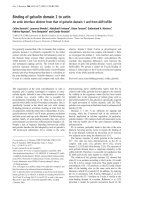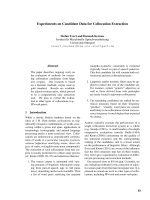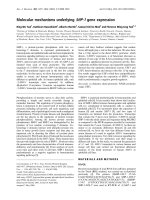Báo cáo y học: " Reflections on off hour admissions to ICU" pot
Bạn đang xem bản rút gọn của tài liệu. Xem và tải ngay bản đầy đủ của tài liệu tại đây (38.54 KB, 2 trang )
Available online />Page 1 of 2
(page number not for citation purposes)
In the June issue of this journal, Meynaar and colleagues [1]
report that there was no excess mortality observed for off
hours admissions to ICU once an adjustment was made for
acute illness severity [1]. We have previously described a
50% relative risk reduction in all cause mortality pursuant to
the establishment of an acute medical admission unit [2].
In our study, only 3.9% of 23,172 emergency medical
admissions were admitted to the ICU. For all patients
admitted between 2002 and 2008, we observed (Table 1) an
increased mortality for evening admissions (admissions
between 16.00 and 00.00 hours), with an odds ratio (OR) of
1.39 (95% confidence interval (CI) 1.15; 1.67). The ‘out of
hours’ effect on 30-day mortality was independently
predictive, despite adjustment for other major outcome
predictors, including acute illness severity, Charlson index
(OR 1.32, 95% CI 1.23; 1.42) and an ICU admission (OR
8.88, 95% CI 6.39; 12.2). The evening effect remained
constant over 7 years. For the subset of 894 patients
admitted to our ICU there was no ‘out of hours’ effect. This
could be explained by lack of power to detect such an effect
in the subgroup, or perhaps patient selection factors for ICU
level care.
We could hypothesize that the increased mortality risk of
evening admissions reflected factors including congestion,
staff fatigue or ‘out of hours’ resource deficit. However,
although the implementation of our acute medical admission
unit lowered mortality by 50%, the ‘out of hours effect’ was
completely unaltered. The literature evidence is of marked
variations in circadian, weekly and seasonal mortality for
major cardiopulmonary and neurological disease - factors
implicated have included endogenous rhythms and external
factors like climatic conditions [3]. Advocacy for increased
resources to compensate for the increased ‘out of hours’
mortality risk may be reasonable. Evidence that underlying
mortality rhythms can be impacted by such measures would
be of great interest.
Letter
Reflections on off hour admissions to ICU
Declan Byrne, Siok Li Chung and Bernard Silke
Department of Pharmacology and Therapeutics, University of Dublin, Trinity College and the GEMS Directorate, St James’ Hospital, Dublin 8, Ireland
Corresponding author: Bernard Silke,
See related research by Meynaar et al., />Published: 25 September 2009 Critical Care 2009, 13:418 (doi:10.1186/cc8030)
This article is online at />© 2009 BioMed Central Ltd
CI = confidence interval; OR = odds ratio.
Table 1
Logistic regression predicting an in-hospital death (versus survival) by 30 days in acute medical patients admitted between 2002
and 2008
Admission type Odds ratio Lower CI Upper CI P-value
Respiratory (MDC 4) 2.13 1.69 2.67 <0.01
Circulatory (MDC 5) 1.96 1.49 2.57 <0.01
Nervous (MDC 1) 2.55 1.88 3.44 <0.01
Charlson Co-morbidity Index 1.32 1.23 1.42 <0.01
ICU stay 8.88 6.39 12.16 <0.01
Evening admission 1.39 1.15 1.67 <0.01
Unit odds ratio adjusted for acute illness score; higher odds ratios indicate a higher likelihood of death; evening admission 16:00 to 00:00 (odds
ratio versus 00:00 to 16:00).
Critical Care Vol 13 No 5 Byrne et al.
Page 2 of 2
(page number not for citation purposes)
Competing interests
The authors declare that they have no competing interests.
References
1. Meynaar IA, van der Spoel JI, Rommes JH, van Spreuwel-Verhei-
jen M, Bosman RJ, Spronk PE: Off hour admission to an inten-
sivist-led ICU is not associated with increased mortality. Crit
Care 2009, 13:R84.
2. Rooney T, Moloney ED, Bennett K, O’Riordan D, Silke B: Impact
of an acute medical admission unit on hospital mortality: a 5-
year prospective study. QJM 2008, 101:457-465.
3. Arntz HR, Willich SN, Schreiber C, Brüggemann T, Stern R,
Schultheiss HP: Diurnal, weekly and seasonal variation of
sudden death. Eur Heart J 2002, 21:315-320.









